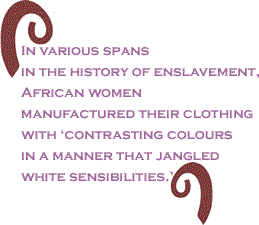
|
|||||||||||||||||||||
|
|
As most know by now, NBA Commissioner David Stern has issued an executive order that predominantly Black players will dress in a "business casual" manner when traveling. This new “dress code” dictates players can no longer leave or arrive at games wearing headphones, sunglasses while indoors, T-shirts, shorts, sleeveless shirts, chains, medallions or pendants. They will be restricted from wearing replica or throwback jerseys and baseball caps to post-game news conferences. Gone will be the sporting for young adoring fans, of gym shoes and other garments with one’s own name, or products manufactured by Black owned and operated companies such as FUBU. Basketball players will dress implicitly unlike basketball players. Across the country journalists, talk show hosts, coaches, parents and others hail the decision as a sudden revelation of decency in sports that will also profoundly impact the quality of their household child rearing. Somehow, if a basketball player leaves his gold chains on the dresser, budding urban ball players like “Little Felicia Walker,” will be provided true discipline and character in their future goals. To call that ridiculous is an understatement. High school principals and others describe the example set by NBA players as strongly influencing impressionable students – an obvious truth. What is alarming is the extent of value they place in such insignificant matters as attire of ball players, most of whom are more centered, thoughtful, and well-behaved than many U.S. Senators. The suggestion that NBA player dress has a direct impact on player conduct is absurd and unproven. We have seen no public attention given to a relationship between (accused and convicted) White corporate executive thieves and the need to restrict crisp white business shirts, suits and ties. There is no public dialogue about how attire might impact moral outcomes with Enron, Worldcom, Tyco, Adelphia Communications and Dynegy executives. Based upon the logic set forth – cloths being the determinant and conduct being the variable – NBA players should dress up, and Corporate CEO’s ought to dress down. Also, NBA players do commonly dress in “business casual” attire and in suits and ties on a regular basis such that the field is easily diverse. Black folk have always been as sharp as we want to be.
On the other hand, I see this decision by Stern as a wildly exciting breakthrough. I hope he places even more restrictive regulations on NBA players. Any corporate patriarchal desire to dress adult Black men against their stated wishes ought to be exposed at every turn. But, also the dominance and control associated with the need to see Black men uniformly dressed is something “politically deficient” (a term lifted from Dr. Cornel West) that Black basketball players need to witness and experience. They need to feel the humiliation of a 63-year-old White man’s domination over what jewelry and shoes they should wear. In my mind, it’s time Eurocentric executives helped us educate some of our towering youthful millionaires to a few realities. Players need to know how their modern experience is so associated with our ancestral stomping-grounds. They need to know that, according to Shane and Graham White, in Slave clothing and African-American culture in the eighteenth and nineteenth centuries (Oxford Journals, 1995), “newly arrived Africans were quickly clothed in European garb and made to conform” to White “concepts of decency.” They need to know about the problem slave masters had with “individual slaves” throughout the American colonies who, “managed to incorporate items of clothing into a ‘look’ that whites found strange and occasionally even unsettling.” It is ironic our culture has been asked to sway from one extreme to another in order to pay homage to European dominance. Historically, for many Whites, “the sight of well-dressed slaves” (italics mine)… aroused suspicion that the wearer might be involved in some sort of illicit activity.” Today, in the current national drama, casual wear quickly arouses Euro-suspicions.
NBA players need to be aware that what is controlled can be less important than submitting to control in and of itself. They need to know legislation was passed entitled, “the South Carolina Negro Act of 1735” which “went so far as to prescribe the materials suitable for slave clothing, allowing only the cheapest fabrics.” While in this case, clothing expenses are not the issue, there is a glaring tie between White need to control strong Africans who were enslaved and the longing to control their African ball-playing descendants. Found among thousands of public runaway posters throughout the colonies was a “bewildering variety” in the attire enslaved Africans wore, demonstrating, “a surprising degree of social and cultural space.” In other words, in defiance of the degrading “Negro Act of 1735,” the enslaved found ways through their dress to distinguish themselves from the look of the cruel, brutal (and jealous) slave master. For you womanist/feminist thinkers – be ye not ignored. The author, Shane White, tells us that in 1744, “less than a decade after the passage of the ‘Negro Act,’ a Grand Jury complained that ‘…Negro Women in particular do not restrain themselves in their Clothing as the Law requires, but dress in Apparel quite gay and beyond their Condition.’" In various spans in the history of enslavement, African women manufactured their clothing with “contrasting colours in a manner that jangled white sensibilities.” We learn from these authors about the past, what we all know is true today – that there were “at least two different and competing value systems operating in eighteenth-century America, and while it appears many of the enslaved were well aware that their actions had meaning in both Euro-American and African American worlds, only a few whites even dimly perceived this to be the case.” In other words, our ancestors were conscious and alert to their pervasive impact – how they were inadvertently bringing depth and cultural wealth to the dominant cultural landscape – while Whites were ostensibly oblivious.
Today, with quadrupled abilities and insight, much of our collective sense of awareness is belly-up. In this case, we find a brilliant group of Black men, locked out of the gates of consciousness of the weight of their impact. We then find a domineering corporate executive making decisions that come barreling down on their natural evolvement, and who is probably keenly aware of their potential to transform the world if they were only culturally and intellectually free. We should all be clear about the however latent intentions of this regulation. Our authors tell us that Whites, “were content to dismiss” African culture as, “little more than unsuccessful attempts by an inferior group to imitate white ways.” As Little Richard has often reminded us, the real anxiety of whites is that too many of them are emulating us. The authors remind us of how enslaved Africans partook in “expressive” forms of dress and music that were, “linked by an underlying rhythm, one that was alien to Euro-American cultural forms.” And they tell us that Whites reacted to our clothing, “as they did to our music, dance and other forms of cultural display, disdaining the individual elements but being impressed, in spite of themselves (italics mine), by the total performance.” In other words, much as with homophobia, they were staunchly bigoted and hateful, but loved us for our presentation.
Now, for those who would rightly argue that Black people across the country also support Stern’s new regulation, please consider that controlling Black people are almost as much a dime a dozen as White ones – and try to restrain any unjustified gloating. At least two relevant points emerge from this discussion. The real political/policy issue is the onslaught of the deliberate shutting down of simple freedoms, and the ravaging of our critical Civil Liberties. Be certain that this rule by Stern has a reinforcing affect on other restrictive conservative edicts such as the Patriot Act and infringements on our privacy. The important cultural/social message these wealthy young men might use to strategize their next play, is that “The South Carolina Negro Act of 1735 proved to be unenforceable…partly because of black determination not to be limited by it (italics mine).” And, with that I say here’s to a fast-break to some 21st Century Black determination. Terry Howcott is a Master of Social Work, Activist, Lecturer, Writer and Thinker. She resides in Detroit, MI and can be reached at [email protected] |
|
| Home | |
Your comments are always welcome. Visit the Contact Us page to send e-Mail or Feedback or Click here to send e-Mail to [email protected] e-Mail re-print notice
If you send us an e-Mail message we may publish all or part of it, unless you tell us it is not for publication. You may also request that we withhold your name. Thank you very much for your readership. |
|
| October 27 2005 Issue 156 |
||||||||
|
||||||||
|
|
||||||||
| Printer Friendly Version in Plain Text or PDF format. Download free Adobe Reader. | ||||||||
 |
||||||||
 |
||||||||
| |
||||||||
| |






























